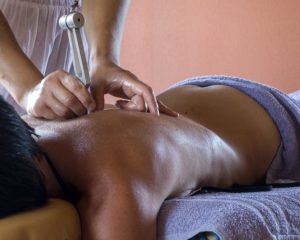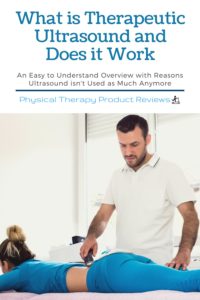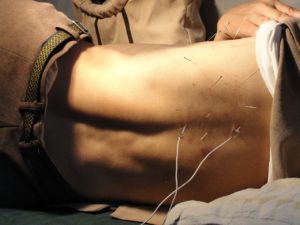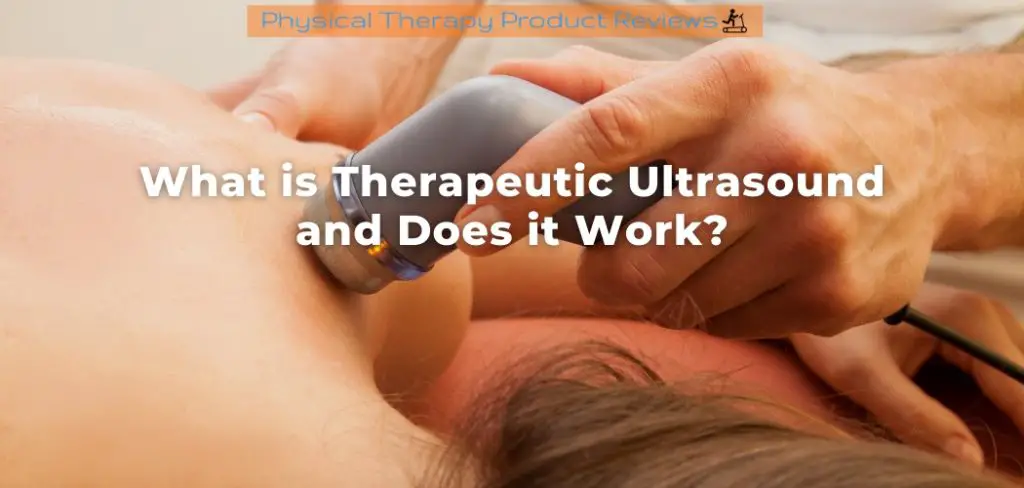There are many modalities used in physical therapy clinics to aid in a patient’s treatment. One such procedure is therapeutic ultrasound, which is a common treatment you’ll find in many medical centers. You might be curious as to what ultrasound is and what it’s supposed to do.
What is Therapeutic Ultrasound?
An ultrasound (US) machine is a device that delivers mechanical energy by way of a high vibration. As the name implies, it does produce sound waves, but at a much higher frequency than we can hear.

This sound wave energy enters the tissues and produces a heating effect. In therapy settings, it is used to treat tendonitis, general pain, and scar tissue.
Ultrasound may be used at the beginning of a physical therapy session or the end after stretching and cooling down. A typical treatment lasts about 10 minutes and may be followed by the use of a moist heat pack.
The use of this treatment dates back to the 1950s when it quickly became wide-spread among Physical Therapists and rehab clinics. It had its 15 minutes of fame, but as research has caught up with the modality, it, unfortunately, doesn’t have much promise.
How does Therapeutic Ultrasound Work?
Energy is transmitted through the vibration of a handheld wand containing a crystal. It almost sounds mythological, but the device works in the following way:
- Electrical energy is applied to the crystal, causing it to vibrate
- The vibration causes piezoelectric waves
- These waves are emitted through the wand head as ultrasound waves
- Ultrasound waves enter the targeted tissue during application
The wand is held against the skin and a viscous gel is used to aid in energy conduction and protect the skin from overheating. Tissues that the wand is directed at will subsequently absorb this energy in the form of heat.
For the reasons stated above, when US is applied to a region of the body, the treating clinician will keep the wand moving constantly. This avoids accidental overheating of tissues, which can cause cell and blood vessel damage.

It’s important that only a trained clinician attempt to perform this treatment.
In Physical Therapy uses, the goal when employing US treatment is to warm the tissues to improve blood flow and aid in the healing process.
It is common to see this modality in use in many Physical Therapy clinics, but the question begs, “does it work?”
Why Ultrasound Not Used Much anymore?
A good amount of research has been completed to understand how ultrasound therapy contributes to a patient’s rehabilitation. Unfortunately, there is no pot of gold at the end of the rainbow.
Multiple high-level studies have demonstrated that US offers no significant contribution to pain management.
Some clinicians do choose to incorporate this treatment into a patient’s regimen if they feel a patient will respond well to it. However, it by no means will make a plan of care complete and, according to the evidence, it’s not likely to provide any value.
 Overall, the studies that have been conducted are largely inconclusive. The evidence just isn’t there as most research results have insignificant findings. Meaning, when ultrasound treatments were compared against fake treatments, there was no difference in patients’ outcomes.
Overall, the studies that have been conducted are largely inconclusive. The evidence just isn’t there as most research results have insignificant findings. Meaning, when ultrasound treatments were compared against fake treatments, there was no difference in patients’ outcomes.
This is concerning as, ideally, all treatments completed with a patient should be evidenced-based and thus likely to elicit positive results. Somehow, the efficacy of ultrasound is often forgotten in the clinic setting as it is easy to apply and many patients enjoy it. Yet, there may be used for it in specific settings.
The science supports that ultrasound does not show significant effects for every patient. But that doesn’t mean that it won’t help any patient.
When administered properly by a trained professional, there are no serious adverse effects of ultrasound. This is likely the reason it has remained in clinics worldwide, despite the lack of supporting evidence for its efficacy.
Alternatives to Ultrasound
We know that the intended purpose of ultrasound treatment is to heat the targeted tissue and improve blood flow to accelerate healing. Such effects can be replicated to a more reliable degree by the use of other modalities, such as:
- Moist heat: used before or after exercise
- Therapeutic exercise: like gentle stretching and strengthening
- Manual Therapy: hands-on treatment like soft tissue mobilization, Gaston, and other techniques
- Trigger point dry needling: an acupuncture-like treatment backed by impressive research
- Electrical Stimulation: a device that delivers electrical pulses to targeted areas and used for multiple purposes

As you can see, there is a range of alternative treatments that will be found in most clinics. Rehabilitation is a collaborative effort, so be sure to discuss treatment options with your provider.
If your doctor is interested in including ultrasound in your therapy, they might have a specific reason. Sometimes it’s acceptable to base treatment off of a theory, but other times it isn’t. Know that there are a lot of other options that are much more supported by research and are likely to yield better results.
An Overview of Therapeutic Ultrasound
Key Takeaways
Therapeutic ultrasound is a mediocre treatment that isn’t significantly supported by scientific evidence. However, when used properly, it commits no harm. For these reasons, you may or may not see it used in your rehabilitation plan, and the good news is, you won’t be any better or worse off because of it.
Remember, you’ll get the most benefit from your active exercises and activities prescribed to you by your Physical Therapist. The modalities they choose to implement into your treatment plan will aid in your rehabilitation as well, but as a supplement to the broader plan of care.
Works Referenced:
Alexander LD, Gilman DRD, Brown DR, Brown JL, Houghton PE. Exposure to low amounts of ultrasound energy does not improve soft tissue shoulder pathology: a systematic review. Physical Therapy. 2010; 90(1):14-25. https://academic.oup.com/ptj/article/90/1/14/2737607
Robertson VJ, Baker KG. A review of therapeutic ultrasound: effectiveness studies. Physical Therapy. 2011: 81(7): 1339-1350. https://academic.oup.com/ptj/article/81/7/1339/2857679
Other Great Health Related Articles
How to Stay Active After Cervical Fractures: Expert Tips and Advice
Dealing with Painful Stairs After Ankle Replacement Surgery
Walking After a Total Ankle Replacement: Tips for a Successful Recovery
Exercises While Non-Weight Bearing After Ankle Replacement: Elevation, AROM, Leg Raises, and More
Ankle Pain with Stairs: Causes and Home Treatment Options
5 Common Mistakes You’re Making After an Ankle Sprain
Disclaimer: The information provided in this post is for educational purposes only. This is not a substitute for a medical appointment. Please refer to your physician before starting any exercise program.







